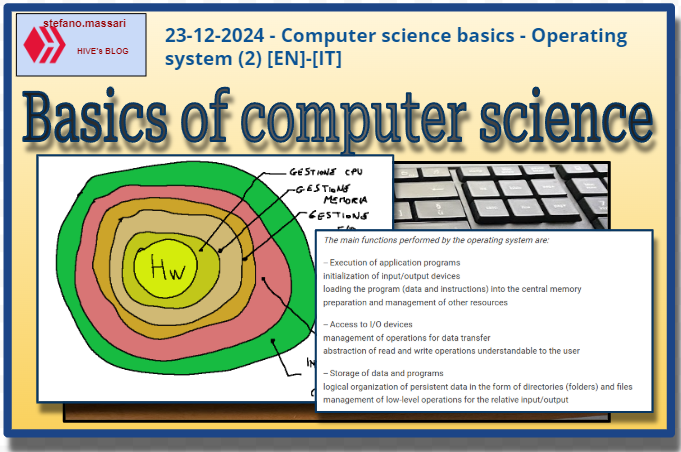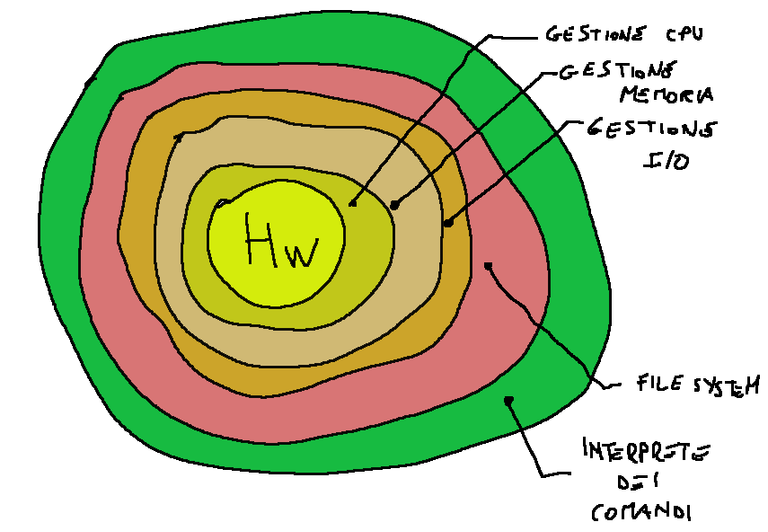
~~~ La versione in italiano inizia subito dopo la versione in inglese ~~~
ENGLISH
23-12-2024 - Computer science basics - Operating system (2) [EN]-[IT]
With this post I would like to give a brief instruction about the topic mentioned in the subject
(code notes: X_82)
Operating system (2)
The operating system has a layered structure, so-called onion, below a scheme.

The Operating System is logically divided into functional layers and each layer offers services to the upper layers hiding what is underneath and its implementation mechanisms.
The main functions performed by the operating system are:
⎯ Execution of application programs
initialization of input/output devices
loading the program (data and instructions) into the central memory
preparation and management of other resources
⎯ Access to I/O devices
management of operations for data transfer
abstraction of read and write operations understandable to the user
⎯ Storage of data and programs
logical organization of persistent data in the form of directories (folders) and files
management of low-level operations for the relative input/output
⎯ Access control
sharing of resources by multiple users or applications
protection mechanisms and policies for resolving any conflicts of use
Accounting
optimization of the response time of interactive programs
accounting of the costs of using the system to users
⎯ Management of malfunctions
detection and, if possible, resolution of any malfunctions caused by hardware failures, or by incorrect operations performed by the software applicative
Here are some information pills regarding the subject in question.
1-single-user multitasking systems
Single-user multitasking systems allow multiple programs and a single user
2-The accounting function
The accounting function performed by the operating system consists in optimizing the response time of interactive programs
3-round robin scheduling algorithm
In the round robin scheduling algorithm, the time quantum must be small
4-security terms
In terms of security, the administrator can access any file or resource
5-dynamic link libraries
Dynamic link libraries contain procedures and functions shared between different applications
6-The operating system layer
The operating system layer closest to the hardware is the CPU manager
7-time quantum
A time quantum is a time interval into which the CPU execution is divided
8-context-switch
For time-sharing, the context-switch represents the switch from one process to another to the other
9-throughput of a system
The throughput of a system is the number of processes completed in the unit of time
10-
In the First-Come-First-Served (FCFS) scheduling algorithm, the queue of ready processes is managed in FIFO (First Input Forward Output) mode
Conclusions
The time quantum (also called time quantum) of a computer is a fixed unit of time used in operating systems to manage the execution of processes on a CPU. It is particularly relevant in preemptive scheduling algorithms, such as Round Robin.
Question
What is your favorite operating system today?

[ITALIAN]
23-12-2024 - Basi di informatica - Sistema operativo (2) [EN]-[IT]
Con questo post vorrei dare una breve istruzione a riguardo dell’argomento citato in oggetto
(code notes: X_82)
Sistema operativo (2)
Il sistema operativo ha una struttura a strati, cosiddetta a cipolla, qui sotto uno schema.

Il Sistema operativo logicamente è suddiviso in strati funzionali e ciascuno strato offre servizi agli strati superiori nascondendo quello che sta sotto e i suoi meccanismi implementativi.
Le principali funzioni svolte dal sistema operativo sono:
⎯ Esecuzione di programmi applicativi
inizializzazione dei dispositivi di ingresso/uscita
caricamento del programma (dati e istruzioni) nella memoria centrale
preparazione e gestione di altre risorse
⎯ Accesso ai dispositivi di I/O
gestione delle operazioni per il trasferimento dei dati
astrazione delle operazioni di lettura e scrittura comprensibili per l’utente
⎯ Archiviazione di dati e programmi
organizzazione logica dei dati persistenti sotto forma di directory (cartelle) e file
gestione delle operazioni di basso livello per il relativo ingresso/uscita
⎯ Controllo di accesso
condivisione di risorse da parte di più utenti o applicazioni
meccanismi di protezione e politiche di risoluzione degli eventuali conflitti d’uso
Contabilizzazione
ottimizzazione del tempo di risposta dei programmi interattivi
contabilizzazione dei costi dell’impiego del sistema agli utenti
⎯ Gestione dei malfunzionamenti
rilevazione e, se possibile, risoluzione di eventuali malfunzionamenti provocati da guasti hardware, o da operazioni non corrette compiute dal software applicativo
Qui di seguito alcune pillole di informazioni a riguardo dell’argomento in oggetto.
1-sistemi multi-tasking mono-utente
I sistemi multi-tasking mono-utente consentono più programmi e unico utente
2-La funzione contabilizzazione
La funzione contabilizzazione svolta dal sistema operativa consiste nel ottimizzare il tempo di risposta dei programmi interattivi
3-algoritmo di scheduling round robin
Nell'algoritmo di scheduling round robin, il quanto di tempo deve essere piccolo
4-termini di protezione
In termini di protezione, l'amministratore può accedere a qualsiasi file o risorsa
5-librerie di collegamento dinamico
Le librerie di collegamento dinamico contengono procedure e funzioni condivise tra diverse applicazioni
6-Lo strato del sistema operativo
Lo strato del sistema operativo più vicino all'hardware è il gestore della CPU
7-quanto di tempo
Un quanto di tempo è intervallo di tempo in cui è suddivisa l'esecuzione della CPU
8-context-switch
Per il time-sharing, il context-switch rappresenta il passaggio da un processo all’altro
9-throughput di un sistema
Il throughput di un sistema è il numero di processi completati nell’unità di tempo
10-
Nell'algoritmo di scheduling First-Come-First-Served (FCFS), la coda dei processi pronti è gestita in modalità FIFO (First Input Forward Output)
Conclusioni
Il quanto di tempo (chiamato anche time quantum) di un calcolatore è un'unità di tempo fissa utilizzata nei sistemi operativi per gestire l'esecuzione dei processi su una CPU. È particolarmente rilevante negli algoritmi di scheduling preemptive, come il Round Robin.
Domanda
Qual è ad oggi il vostro sistema operativo preferito?
THE END



